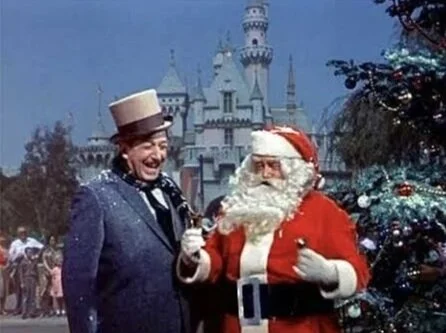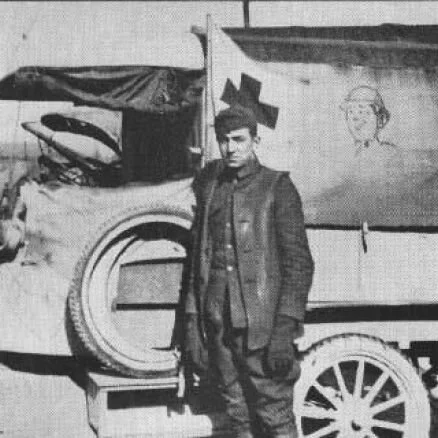Walt Disney - Early Companies & Early Films
Welcome to part 2! You've learned about Walt's family background, some of the jobs that his father had, and Walt's first introduction to cartooning. Now you will learn about what he decided to do with his new found talent and where it lead him.
Walt had dropped out of school at 16 years old to join the war efforts as World War I was occurring at the time. He ended up with the Red Cross, and drove an ambulance in France. Once he returned home from his quest at war, he had considered going back to a regular job, where he could make stable income, and where his father would prefer him to be. But because we know how spontaneous and bold he is, he of course did not go that route, but rather wanted to find a career as an artist; since cartooning in high school was something he really enjoyed.
His older brother Roy was working at a bank in Kansas City at the time, and overheard one of his coworkers talking about an art shop that needed an apprentice. Roy was supportive of his brother and his dreams, and quickly passed along the message. Walt packed up his things in Chicago and moved to Kansas City, where he would work for Gray Advertising Company. Walt made around $50 a month, and then increased to $35 a week, which is a decent salary to have at the time. He was thrilled that he got to do what he loved and get paid for it. Gray Advertising is also where Walt met Ub Iwerks, as they worked alongside each other and complimented each other nicely. Walt would sketch everything out, and Ub would fill it in with the colour.
Walt and Ub Iwerks
After working at this company for a while and growing a friendship with Ub, Walt got bold again, and decided it was time to have his own company and work with Ub and a few other artists.
Despite what you may think - this is not where Walt Disney Studios began. In fact, Disney's first company was called "Laugh-O-gram Films Inc".
Walt and his artists created 6, one-reel cartoons, all based on fairytales, just as his later films are as well. He did stories like Little Red Riding Hood, Jack and the Beanstalk, and even Cinderella.
Laugh-O-gram Films inc business card
Walt's new studio worked hard from 1921-1922 to produce these films, until he signed a contract that eventually lead them into bankruptcy. He had been doing so well with his company, he was able to pay all of his employees, and it all went downhill within 2 years. In 1923, he wrote his last story with his animators, which had a new approach with how it would be filmed. It would be live-action... feature a little girl as the star... he drew inspiration for the girl from Virgina Davis... and he titled it "Alice's Wonderland". He filed for bankruptcy, left the studio, and took his story of Alice with him.
Laugh-O-gram Films inc. bankruptcy papers
Now what was he to do? Well, if you hadn't caught on already, Walt is a bold decision maker. Where do artists go when they're looking for big careers with their big dreams? Hollywood.
“I came to Hollywood and arrived here in August 1923 with forty dollars in my pocket and a coat and a pair of trousers that didn’t match. And one half of my suitcase had my shirts and underwear and things and the other half had my drawing materials.”
Alice Comedies promotional poster
Disney was worried about his chances of finding a job, Hollywood was full of artists and he wasn't sure whether he was joining the game too late. But, after many applications and searches later, he was able to get a contract with Winkler Pictures and sign off on 12 of his short films about his new character Alice.
He renamed "Alice's Wonderland" to the "Alice Comedies", and worked on them with his brother Roy, who still supported his animation dreams, and they opened a new studio together. Walt was only 21, but had big plans for Alice. In 1924 with his new studio in place, he hired more artists from Kansas City, and one of them is Lillian Bounds, Walt's later-to-be wife.
The 1920s was when major film studios were being established that are still around today, including Warner Bros, MGM, and the Academy of Motion Picture Arts and Sciences. Despite all of this new competition, the Disney's were extremely successful with the Alice Comedies, and he made a name for himself in the industry.
Oswald the Lucky Rabbit, 1928
In 1925, Roy married his wife Edna Francis, and Walt married his wife Lillian Bounds. With their new found love and drive to grow bigger, the Disney studio moved to Hyperion Avenue in Los Angeles. They created the Alice Comedies for the next 2 years after, finishing in 1927. Walt's next big project was for Universal Studios, as they needed a new character to replace Felix the Cat, whom was very popular at the time. Walt, Ub Iwerks, and his team created Oswald the Lucky Rabbit.
For the next year, Oswald was a huge hit with all audiences. This is the character that majority of Disney fans now still think of when they think of vintage Disney classics. I'm planning on doing a whole separate post about what went down with Oswald after this series is over, so look out for that.
In February 1928, Walt lost the rights to Oswald to Charles Mintz, whom also stole all of Walt's animators except Iwerks. This was a low point for him, as his high took a deep dive. Fortunately enough, this huge loss became one of the most iconic revenge stories ever, and secured the Disney name in households forever. Right after this loss, on a train home from New York, Disney created Mickey Mouse.
The first known drawing of Mickey Mouse
Mickey became the star of a new animated series that was instantly successful, titled "Mickey Mouse Sound Cartoons". Iwerks spent long hours and long days animating this series, creating over 700 drawings per day for Walt. On May 15th, 1928, only 3 months after losing Oswald, Iwerks drew, animated and produced the very first episode titled "Plane Crazy". Mickey did not even have his signature gloves or shoes yet.
Mickey Mouse, Plane Crazy
Mickey Mouse in Karnival Kid exclaiming “hot dog!”
A famous short from the series “Steamboat Willie” paved the way for animators in the future, especially with the use of sound. On November 18th 1928, the short titled “Steamboat Willie'“ was the first animated short to have synchronized sound. November 18th is now Mickey Mouse’s birthday. On May 28th 1929, we heard Mickey say his first words in “Karnival Kid”, which are “hot dog!”
The last major step Walt took during this time for animation that was completely new and innovative, was adding color to his cartoons. Technicolor was introduced in 1932, and by 1935, all of Disney's films were made in color.
“Color was new. Walt just wanted to do it. He was always interested in new things.”
The next post in the series will talk about the Vault films, which is really what this blog is all about. It'll include original preserved sketches, original storylines, and bumps in the road along the way. I hope you've learned a little about where our beloved Mickey comes from, and all of the studios that came before him.
**credit for info and some pictures go to the Walt Disney Family Museum















